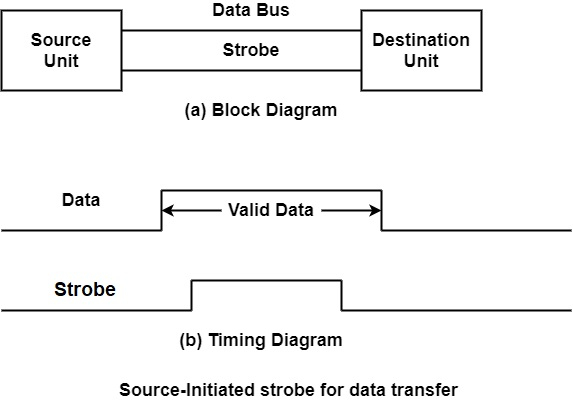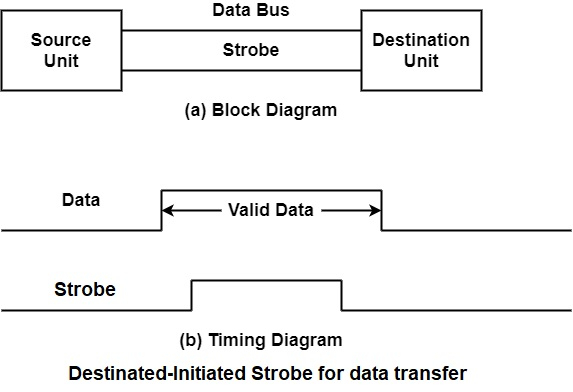
 Data Structure
Data Structure Networking
Networking RDBMS
RDBMS Operating System
Operating System Java
Java MS Excel
MS Excel iOS
iOS HTML
HTML CSS
CSS Android
Android Python
Python C Programming
C Programming C++
C++ C#
C# MongoDB
MongoDB MySQL
MySQL Javascript
Javascript PHP
PHP
- Selected Reading
- UPSC IAS Exams Notes
- Developer's Best Practices
- Questions and Answers
- Effective Resume Writing
- HR Interview Questions
- Computer Glossary
- Who is Who
What is Strobe Control?
The strobe control technique of asynchronous data transfer operates a single control line to time each transfer. The strobe can be activated by either the source or the destination unit. The diagram shows a source-initiated transfer.

The data bus gives the binary data from the source unit to the destination unit. Generally, the bus has multiple lines to transfer a unified byte or word. The strobe is a single line that instructs the destination unit when an accurate data word is accessible in the bus.
As displayed in the timing diagram of figure (b), the source unit first places the data on the data bus. After a short delay to provide that the data achieve a constant value, the source activates the strobe pulse. The data on the data bus and the strobe signal remains in the active state for enough period to enable the destination unit to receive the data.
The destination unit helps the lowering edge of the strobe pulse to send the contents of the data bus into one of its internal registers. The source deletes the data from the bus for a short period after it disables its strobe pulse. The source does not have to modify the data in the data bus. The case that the strobe signal is disabled signifies that the data bus does not include correct data. New correct data will be available only after the strobe is allowed again.
The diagram shows a data transfer proposed by the destination unit. In this method, the destination unit activates the strobe pulse, advising the source to support the data. The source unit counter by storing the requested binary data on the data bus. The data should be true and remain in the bus long sufficient for the destination unit to accept it.

The falling edge of the strobe pulse can be used to produce a destination register. The destination unit then disables the strobe. The source eliminates the data from the bus after a fixed time interval. In several computers, the strobe pulse is guarded by the clock pulses in the CPU.
The CPU is continually in control of the buses and update the external units on how to transfer information. For example, the strobe can be a memory-write control signal from the CPU to a memory unit. The source, being the CPU, locates a word on the data bus and updates the memory unit, which is the destination, that this is a write operation.
Correspondingly, the strobe can be a memory-read control signal from the CPU to a memory unit. The destination, the CPU, starts the read operation to update the memory, which is the source, to locate a selected word into the data bus.
The transfer of data between the CPU and an interface unit is the same as the strobe transfer. Data transfer between an interface and an I/O device is generally reserved by a set of handshaking lines.

